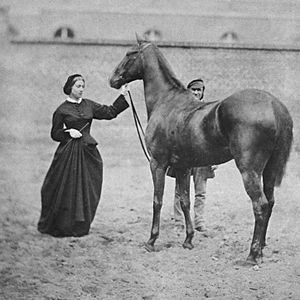Alexine Tinne facts for kids
Quick facts for kids
Alexine Tinne
|
|
|---|---|
 |
|
| Born | 17 October 1835 The Hague, Netherlands
|
| Died | 1 August 1869 (aged 33) Ottoman Tripolitania
|
| Occupation | Explorer |
Alexandrine "Alexine" Tinne (born October 17, 1835 – died August 1, 1869) was a brave Dutch explorer. She was the first European woman to try and cross the huge Sahara Desert. Alexine was also one of the first photographers.
Contents
Early Life and Wealth
Alexine Tinne was born in The Hague, Netherlands. Her father was Philip Frederik Tinne, a rich Dutch merchant. Her mother was Baroness Henriette van Capellen. Philip Tinne was involved in the spice trade across the Atlantic Ocean. He also owned coffee farms in what is now Guyana.
His company, Sandbach, Tinne & Company, owned ships and farms. This company made a lot of money from the trade of goods like sugar. When slavery was ended in 1833, his company received a very large payment. This made Alexine the richest woman in the Netherlands when her father died. She was only ten years old at the time.
Education and Hobbies
Alexine was taught at home. She was very good at many things. She enjoyed painting, playing the piano, and learning new languages. She also loved geography.
Alexine became interested in photography. She took pictures in her hometown of The Hague and its harbor, Scheveningen. She worked with famous photographers like Robert Jefferson Bingham and Francis Frith.
Adventures in Africa
In the summer of 1861, Alexine began her adventures in Africa. She traveled with her mother, Harriette, and her aunt. They went to the White Nile region. After a short stay in Khartoum, they traveled up the White Nile. They were the first European women to reach a place called Gondokoro.
Alexine became very sick, so they had to go back. They returned to Khartoum in November. Soon after, they met two other explorers, Theodor von Heuglin and Hermann Steudner. Together, they planned a new journey. They wanted to explore the Bahr el Ghazal River, which is a branch of the White Nile. They hoped to reach lands further west.
Difficult Journeys
The group started their new trip in early 1862. They traveled up the Bahr el Ghazal River as far as their boats could go. Then, they continued their journey overland. They crossed rivers and went deep into unknown areas.
This journey was very hard. Many of the travelers got sick with fever. Sadly, a student died in April. Alexine's mother died in July, and two Dutch maids also passed away. After many challenges, Alexine and the remaining group reached Khartoum in March 1864. There, Alexine's aunt, who had stayed behind, also died.
Alexine buried her aunt and one maid in Khartoum. She brought the bodies of her mother and the other maid back to Cairo. Her half-brother, John Tinne, visited her in Cairo. He tried to convince her to return home, but she decided to stay. John took the bodies of her mother and maid back to Europe. He also took a large part of her collection of African items. These items were later given to the World Museum in Liverpool.
Life in Cairo
For the next four years, Alexine lived in Cairo. She lived in an "Oriental style," which means she adopted some local customs. She also traveled to other places around the Mediterranean Sea, like Algeria and Tunisia. She tried to reach the Tuareg people in 1868, but this attempt was not successful.
Final Journey and Death
In January 1869, Alexine decided to try again to reach the Tuareg people. She started her journey from Tripoli, Libya. Her plan was to travel across the desert to Lake Chad. From there, she hoped to reach the upper Nile River.
In a town called Murzuq, she met another explorer, Gustav Nachtigal. They planned to cross the desert together. However, Nachtigal wanted to go to the Tibesti Mountains first. So, Alexine decided to continue her journey south on her own.
The Attack
Her group moved slowly. Alexine was suffering from health problems, like gout and eye pain. This made it hard for her to keep order among her travel companions.
On August 1, 1869, in the early morning, a terrible event happened. Alexine was traveling on the road from Murzuq to Ghat, Libya. She was attacked and murdered. Two Dutch sailors traveling with her were also killed.
It is believed that Tuareg people working with her guards were responsible. At a trial later, it was said that she was hit with a sword and left to bleed.
Why Did It Happen?
No one knows for sure why Alexine was killed. There are a few ideas:
- Some thought her attackers believed her metal water tanks were full of gold.
- Another idea is that her death was part of a fight between local Tuareg leaders. Some believe it was a way to show that a powerful leader, Ikhenukhen, could not protect travelers. This last idea seems the most likely.
Alexine's Legacy
It was once thought that Alexine's collections of African items in Liverpool were destroyed during a bombing in 1941. However, recent studies show that about 75% of her collection survived. These items are very important. They show what life was like in Sudan during her journeys.
A small marker in Sudan remembers her name. There is also a window plaque in Tangiers. Many of her letters and papers from Africa are kept in the National Archive in The Hague. Her photographs are also stored there.
See also
 In Spanish: Alexine Tinne para niños
In Spanish: Alexine Tinne para niños


